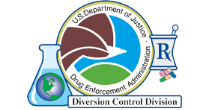About Us
Program Description
The mission of DEA's Diversion Control Division is to prevent, detect, and investigate the diversion of controlled pharmaceuticals and listed chemicals from legitimate sources while ensuring an adequate and uninterrupted supply for legitimate medical, commercial, and scientific needs.
Diversion of Controlled Pharmaceuticals
Many of the narcotics, depressants, and stimulants manufactured for legitimate medical use are subject to abuse and have, therefore, been brought under legal control. Under federal law, all businesses that import, export, manufacture, or distribute controlled substances; all health professionals licensed to dispense, administer, or prescribe them; and all pharmacies authorized to fill prescriptions must register with the DEA. Registrants must comply with regulatory requirements relating to drug security and recordkeeping. The DEA is also obligated under international treaties to monitor the movement of licit controlled substances across U.S. borders and to issue import and export permits for that movement.
Diversion investigations involve, but are not limited to, physicians who sell prescriptions to drug dealers or abusers; pharmacists who falsify records and subsequently sell the drugs; employees who steal from inventory and falsify orders to cover illicit sales; prescription forgers; and individuals who commit armed robbery of pharmacies and drug distributors.
Diversion of Listed Chemicals
In addition to other drugs of abuse, today's illicit drug market offers an assortment of purely synthetic drugs that are abused by both young and old alike. These drugs are often illegally manufactured or synthesized in clandestine laboratories that require chemicals to synthesize, extract, and purify these drugs. Frequently, these clandestine laboratories pose significant public health and safety issues. Therefore, DEA has long recognized the need to monitor and control these chemicals. The enactment of the Chemical Diversion and Trafficking Act of 1988, the Domestic Chemical Diversion Control Act of 1993, the Comprehensive Methamphetamine Control Act of 1996, the Methamphetamine Anti-Proliferation Act of 2000, and the Combat Methamphetamine Epidemic Act of 2005 have established DEA's foundation to prevent chemical diversion.
The Diversion Control Division consists of diversion investigators, special agents, chemists, pharmacologists, program analysts, and others. The office's activities include: determination of program priorities; field management oversight; coordination of major investigations; drafting and promulgation of regulations; establishment of national drug production quotas; fulfillment of U.S. obligations under drug control treaties; design and proposal of national legislation; advice and leadership on state legislation/regulatory initiatives; legal control of drugs and chemicals not previously under federal control; control of imports and exports of drugs and chemicals; computerized monitoring and tracking of the distribution of certain controlled substances; liaison with industry; and the planning and allocation of program resources.




